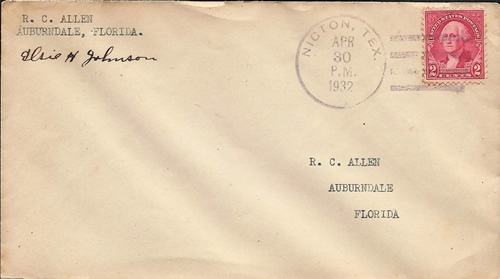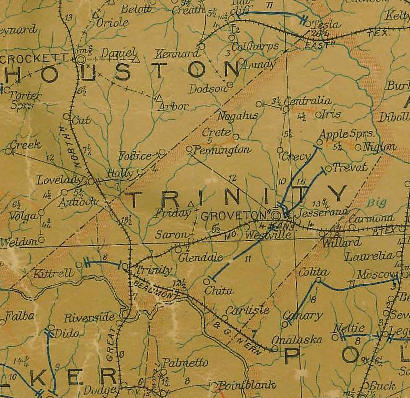Nigton, Texas, Trinity County. (original) (raw)
History in a Pecan Shell
Settled by former slaves in 1873, the name was suggested by former slave and civic leader Jeff Carter. Nigton was primarily a farming community and had its own post office from 1894 to 1923. By 1896 the town had a thriving population of 500 people along with a sawmill, cotton gin, wagon maker, and three churches.
By the 1940s only ten residents still lived in Nigton although that has increased to an estimated 34 people in the 1990s. Residents are direct descendants of the original African-American settlers.
Scattered dwellings are in disrepair and there are no signs to verify you�ve arrived.
In 2017, Nigton received an official Texas Historical Marker at the Junction of FM 2262 and FM 2501
Trinity County 1907 Postal map showing Nigton ›
Historical Marker:
Nigton Community
Following emancipation, African Americans in the northeast part of Trinity County formed the freedom colony of Nigton, east of Apple Springs. Many stayed close to their former plantations, working as farm laborers, engaging in share cropping or owning their own farms or ranches.
The 1880s saw an increase in population and African American land ownership, and the community began to thrive with a diverse agricultural and civic landscape. Nigton was noted for its well-planned farms, fine cattle, hogs, poultry, produce and a high standard of living. Jefferson Calhoun Carter (1855-1936), a landowner, school teacher and progressive leader, was one of the first graduates from Wiley College in Marshall. He promoted pride in the community that continued past his death in 1936. Education was an integral part of the community with land donated in 1888 for a school, named Pine Island School. The community received a Rosenwald grant for a school in 1927-28 and raised over $5000 in bonds and donations. Programs were offered to elementary through high school students with four teachers and a shop room, and acted as a county training school. Noted teacher and scholar, Professor Wayne Wright Johnson (1879-1969), taught at the school from 1910 to 1950. A graduate of Prairie View A&M college and a student of botany, he became the principal of the Nigton school and was committed to the education of Nigton.
The community established the Mayo Baptist Church, Pine Grove colored Methodist Episcopal Church (also known as Ligon Chapel), St. John Union, Masonic Lodge and several retail stores and shops. Prohibited from white events, the community formed their own sporting events and celebrations, including baseball, basketball and community barbeques in June in celebration of Juneteenth.
(2016)
Nigton, Texas Forum
"[Texas Escapes show[s] it being founded in 1873, In Frederick Law Olmsted's book, A Trip across Texas, he visited [the town] in his trip. This trip was in the late 1850's.
It was formed by free Blacks, some of whom owned slaves themselves. The town was described as larger than some of the now famous Texas towns." - L. J. Parker, November 03, 2012
See Texas Black History ›

Texas Escapes, in its purpose to preserve historic, endangered and vanishing Texas, asks that anyone wishing to share their local history, stories, landmarks and recent or vintage photos, please contact us.
